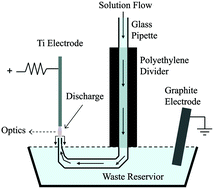Spectroscopic characterization of ion and electron populations in a solution-cathode glow discharge
Abstract
The ion and electron populations of a glow discharge that uses an electrolytic solution as the cathode (an electrolyte-cathode discharge or ELCAD) were investigated. This paper presents the first determinations of electron number density, ionization temperature, and degrees of ionization in the ELCAD. Spectroscopic techniques were used to keep from perturbing the plasma, a range of conditions was explored, and two regions (the negative glow and the positive column) were observed. By using the Stark broadening of the hydrogen beta line, electron number densities near 8.5 × 1014 cm−3 for the negative glow and 2.5 × 1014 cm−3 for the positive column were found. From those results and measurements of the relative strengths of Mg neutral and ionic lines, ionization temperatures of 5000 K for the negative glow and 4600 K for the positive column were calculated. From these results, the degrees of ionization and norm temperatures were estimated for a variety of elements. Analytical implications of the study are discussed.


 Please wait while we load your content...
Please wait while we load your content...